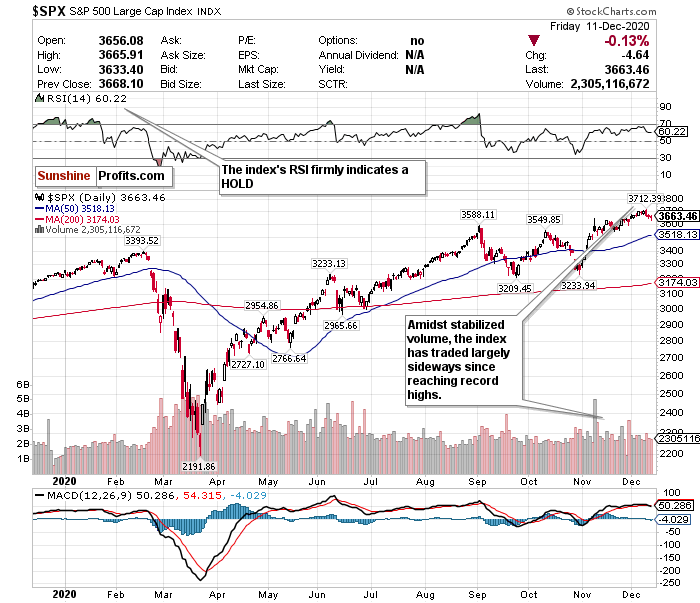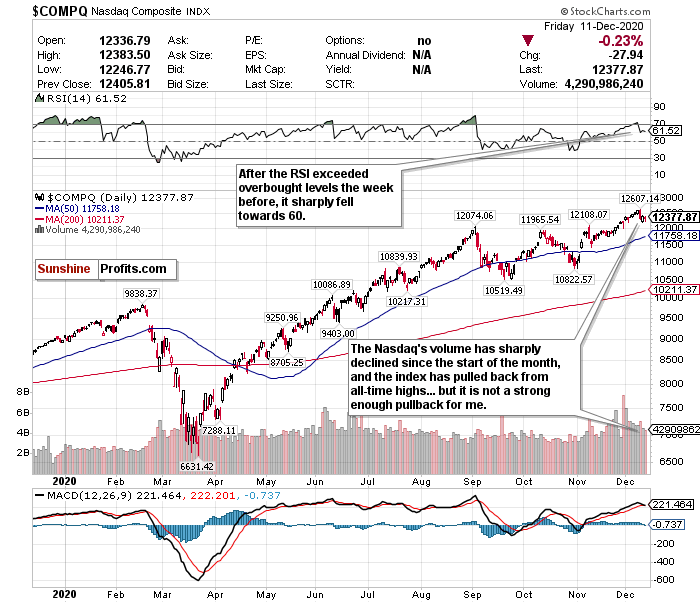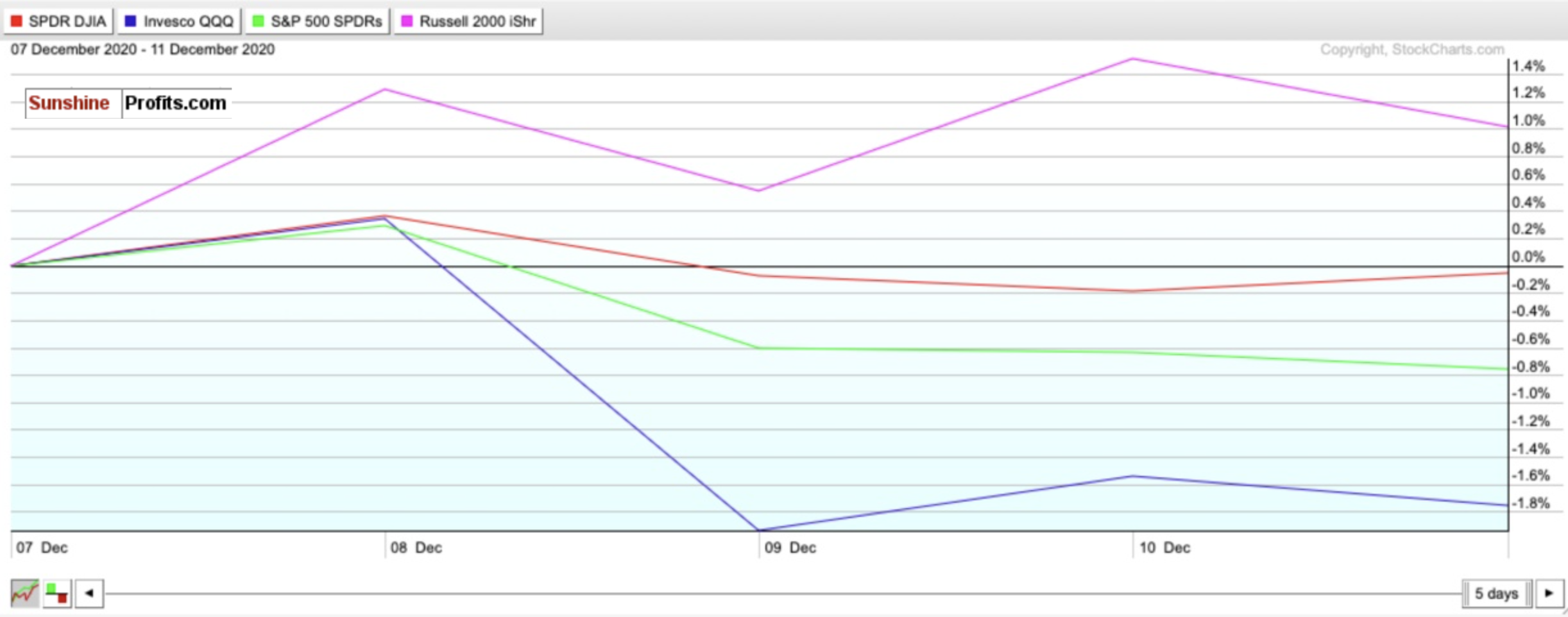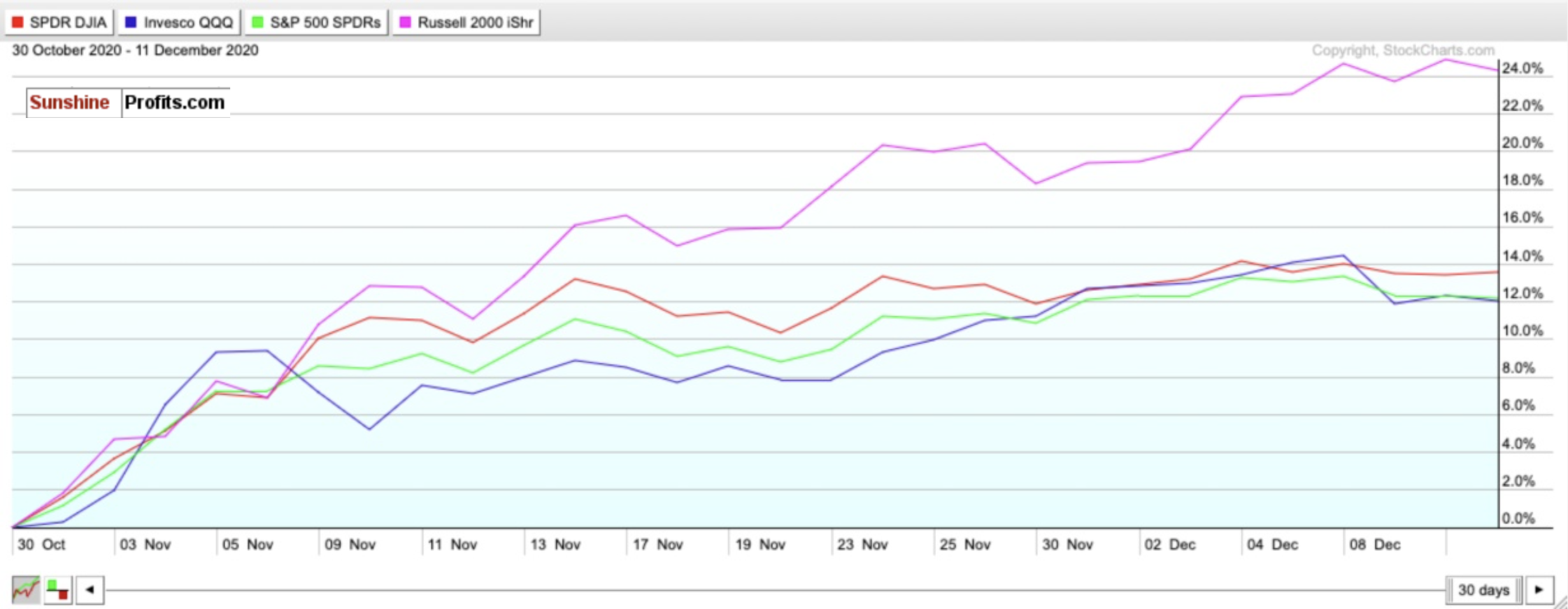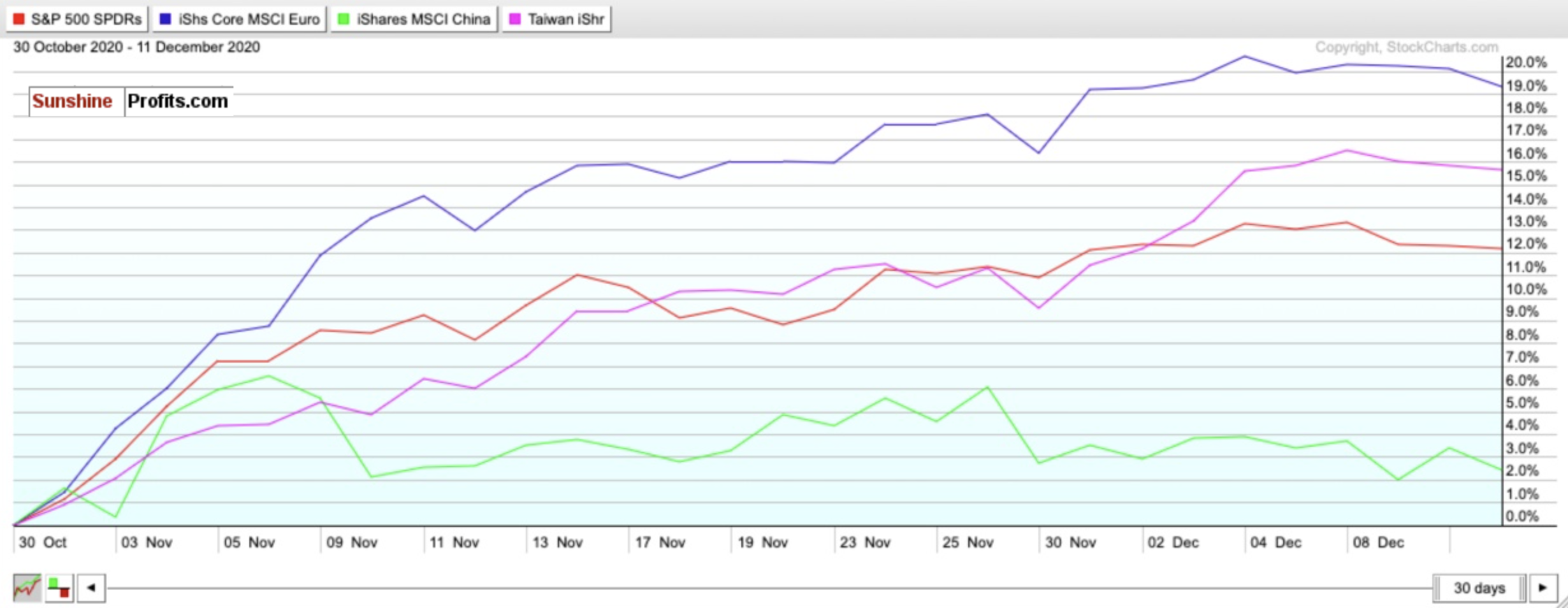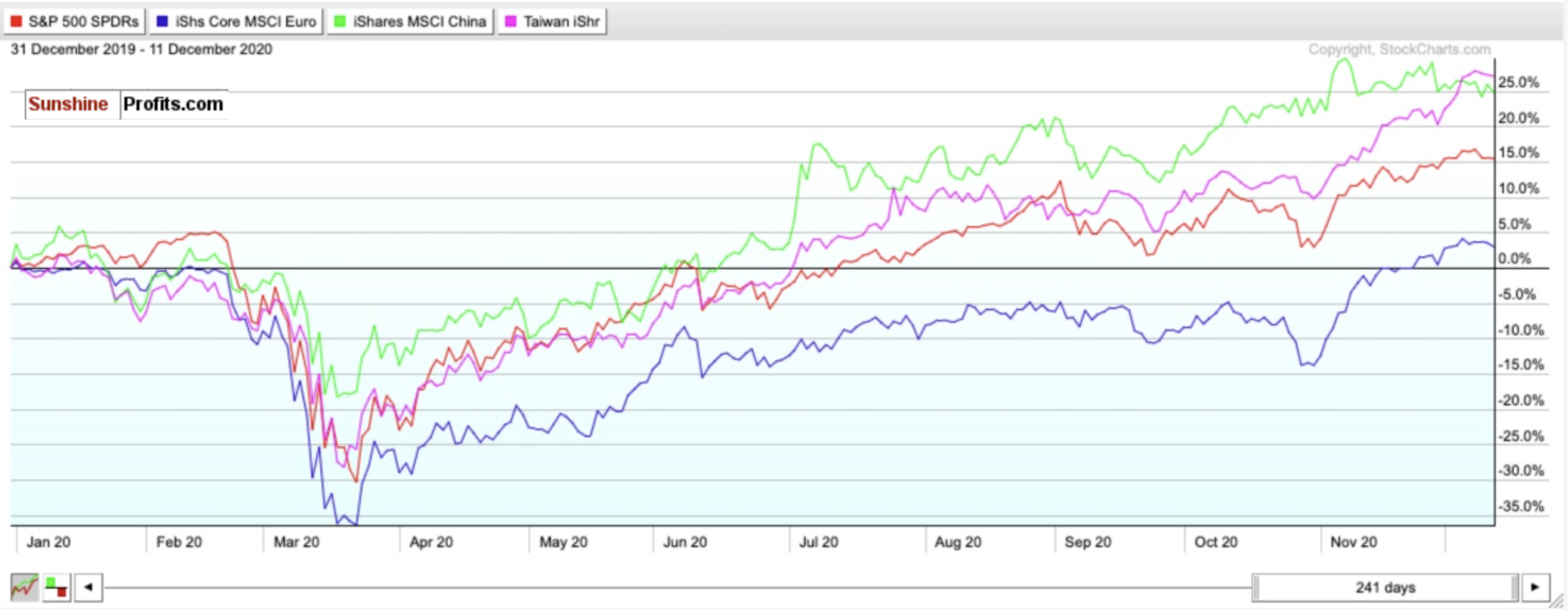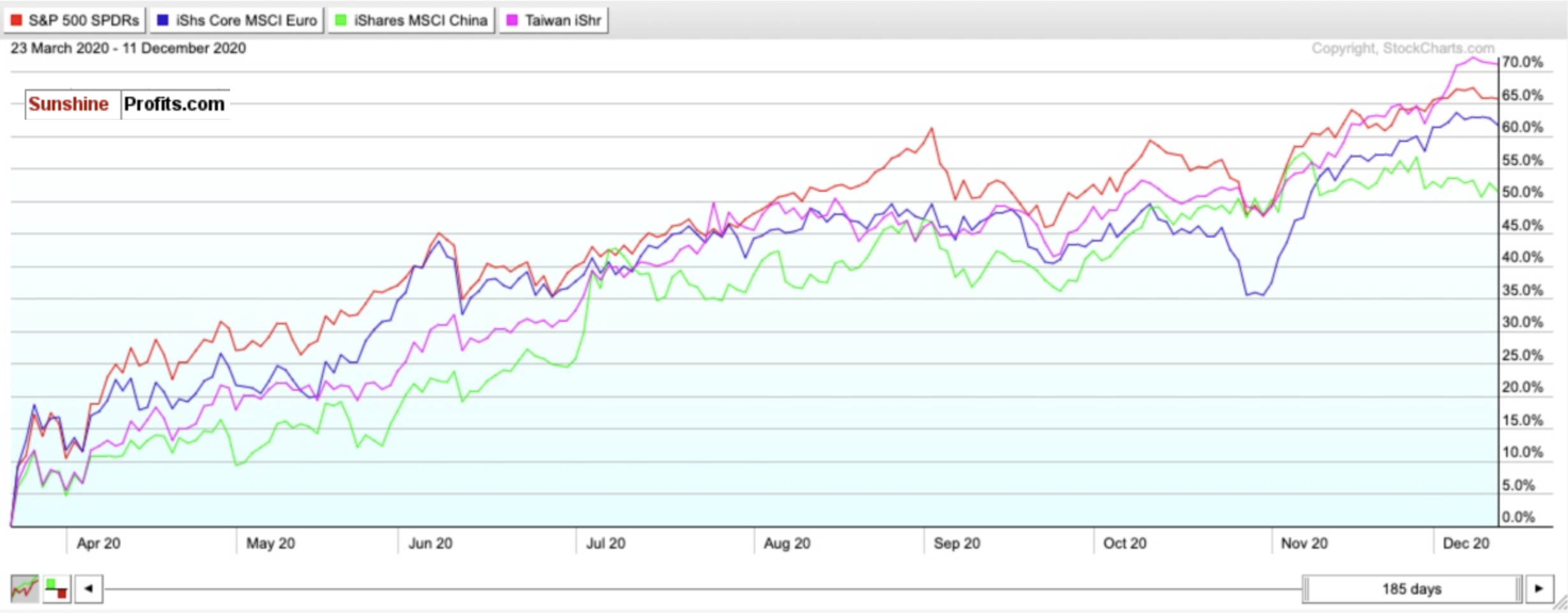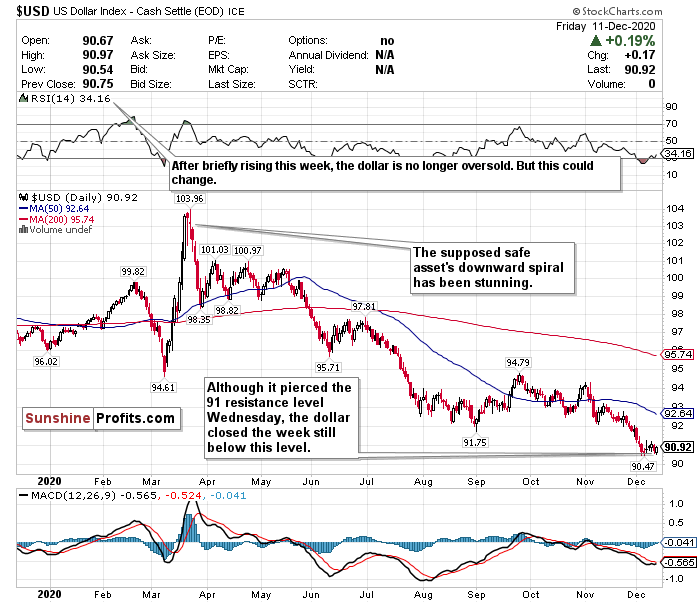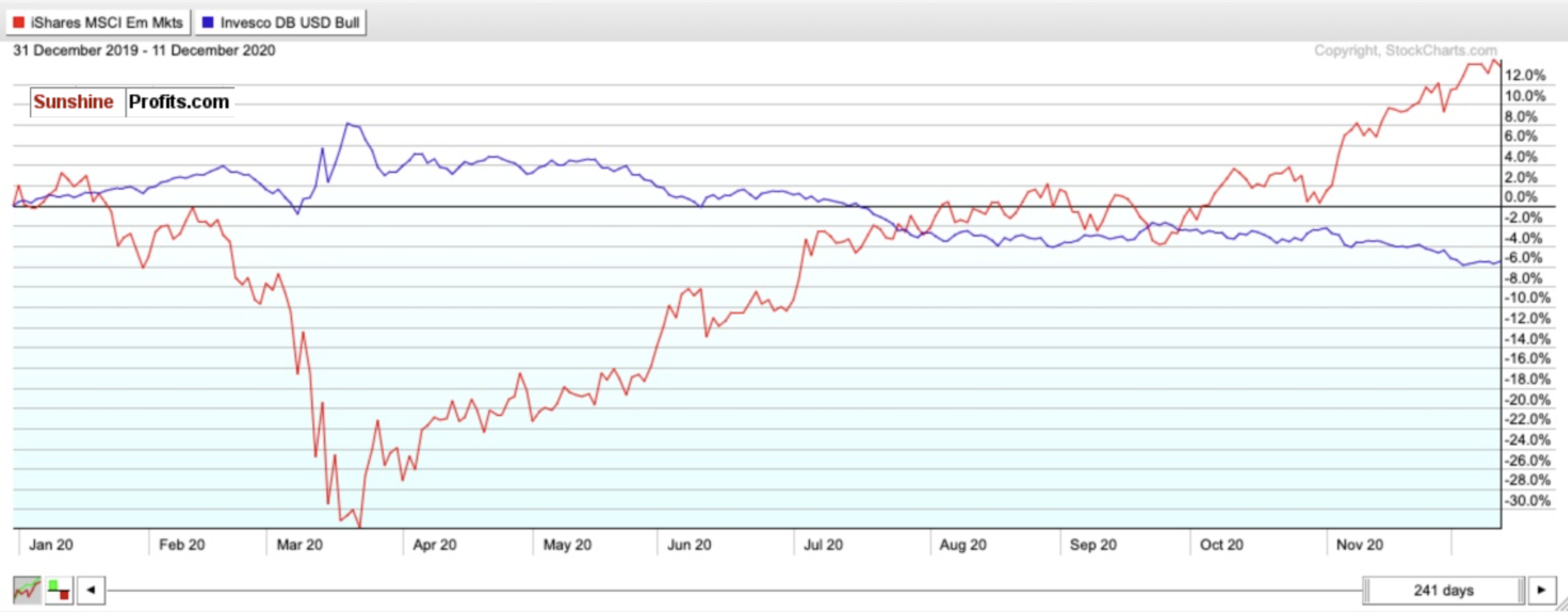Stocks closed mixed on Friday (Dec. 11) amidst further impasses in stimulus talks, horrifying COVID-19 numbers, and vaccine hopes.
News Recap
- The Dow closed 47.11 points higher for a gain of 0.35%, the S&P 500 fell 0.13%, and the Nasdaq dropped 0.23%. The small-cap Russell 2000 also fell by 0.57%.
- After fresh record highs were reached last week, the major indices ended the week lower for the first time in several weeks.
- The Senate unanimously passed a temporary spending bill to avoid a government shutdown and buy more time to negotiate a stimulus package before the end of the year.
- Congress remains deeply divided on the next stimulus package. Much of the division still stems from liability protections for businesses, the scope of state and local aid, and weekly unemployment benefits.
- COVD-19 continues to ravage the country. After exceeding 3,000 deaths a day for several days last week, Friday’s tallies, according to NBC News, showed 2,890 deaths and 226,024 new cases. In the last week the U.S. has averaged 211,324 cases and 2,381 deaths per day, which is a significant increase from 168,493 cases and 1,419 deaths four weeks ago.
- Disney (DIS) led the markets and closed up 13.6% on the day after revealing impressive projections on its streaming service’s subscribers.
- On the vaccine front in the U.S., the F.D.A. officially cleared Pfizer and BioNTech’s vaccine. After the U.K. became the first country in the world to approve the vaccine’s usage, the U.S. finally gave its stamp of approval and is expected to ship millions of doses as soon as possible.
While the short-term may see some pain and/or mixed sentiment, the mid-term and long-term optimism is certainly very real. Overall, the general consensus between market strategists is to look past the short-term painful realities and focus more on the longer-term- a world where COVID-19 is expected to be a thing of the past and we are back to normal. With the FDA approval of Pfizer’s vaccine, we are firmly on that path - despite the very harsh headwinds in the short-term.
According to Robert Dye, Comerica Bank Chief Economist:“ I am pretty bullish on the second half of next year, but the trouble is we have to get there...As we all know, we’re facing a lot of near-term risks. But I think when we get into the second half of next year, we get the vaccine behind us, we’ve got a lot of consumer optimism, business optimism coming up and a huge amount of pent-up demand to spend out with very low interest rates.”
Other Wall Street strategists are bullish on 2021 as well. According to a JPMorgan note to clients released on Wednesday (Dec. 9), a widely available vaccine will lift stocks to new highs in 2021.
JPMorgan’s S&P 500 target for 2021 is 4,400. This implies a nearly 20% gain from where the index closed on Wednesday (Dec. 9).
On the other hand, for the rest of 2020, and maybe early on into 2021, markets will wrestle with the negative reality on the ground and optimism for an economic rebound.
Additionally, the rally since election week invokes concerns of overheating with bad fundamentals. Commerce Street Capital CEO Dory Wiley advised caution in this overheated market. He pointed to 90% of stocks on the NYSE trading above their 200-day moving average as an indication that valuations might be stretched.
In the short-term, there will be some optimistic and pessimistic days. On other days, (in my opinion, this will be most trading days) markets will trade largely mixed, sideways, and reflect the uncertainty. However, if a stimulus deal passes before the end of the year, it could mean very good things for short-term market gains. It is possible that there could be a minor compromise reached before the end of the year, however, a more large-scale comprehensive package may not be agreed to until 2021.
In the mid-term and long-term, there is certainly a light at the end of the tunnel. Once this pandemic is finally brought under control and vaccines are mass deployed, volatility will stabilize, and optimism and relief will permeate the markets. Stocks especially dependent on a rapid recovery and reopening, such as small-caps, should thrive.
Due to this tug of war between sentiments, it is truly hard to say with conviction that another crash or bear market will come.
Therefore, to sum it up:
While there is long-term optimism, there is short-term pessimism. A short-term correction is very possible. But it is hard to say with conviction that a big correction will happen.
The S&P Has Long-term Upside Mixed with an Uncertain Short-term
Many analysts and strategists believe this short-term uncertainty is worth it for long-term potential. Some analysts believe the S&P could have up to a 20% upside in 2021, while others caution against an overheating index. According to another survey of market strategists conducted by CNBC, a narrow majority believe that U.S. stocks will continue to rally into 2021, with the S&P 500 rising between 8% and 22% next year from these current levels. This very well could be the case - but I personally believe most of this will happen in the next 6-12 months rather than 1-3 months.
While the S&P has certainly skyrocketed to unprecedented levels at a breakneck pace, and hit a record high on December 8th, since then, the S&P has declined 1.05%. There are also a few indicators that show that the S&P could face some near-term volatility. But it is difficult to say with conviction that there will be a major downturn.
I agree with all of the analysts that are uncertain about the S&P in the short-term and are bullish in the long-term due to the multitude of headwinds right now. I definitely think that some short-term pain is worth it for some long-term gains. Although the volume has largely stayed stable since Thanksgiving, the RSI of 60.22 keeps the S&P in a HOLD category, while teetering around overbought.
Because of how far and fast the S&P 500 has risen, a further pullback from these elevated levels would not be a shock… but another surge based on good news would not be a shock either. Because of all of the uncertainty, a HOLD for the S&P is an appropriate call. For an ETF that attempts to directly correlate with the performance of the S&P, the SPDR S&P ETF (SPY) is a good option.
Tech IPOs Invoke Fears of Dotcom Bubble - Volume Has Declined and Valuations Have Heated
The NASDAQ’s pullback last week may actually be a good thing for the index. Since peaking on December 8th, the tech-heavy index has declined by 1.63%. But because tech valuations have reached astoundingly inflated levels, and the IPOs of DoorDash (DASH) and AirBnB (ABNB) last week invoked memories of the dotcom bubble, it was not a strong enough pullback for me to confidently make a BUY call on the index or sector. I believe that more pullbacks along the lines of Wednesday (Dec. 9) are more inevitable and would make me feel more confident about initiating tech positions at lower valuations.
After exceeding an overbought RSI level of 70, the pullback on Wednesday brought it back down to a healthier level. The index closed the week with an RSI of 61.52. While this RSI is high, it is not quite overbought. If the index rallies again and exceeds 70, then you may want to consider selling. While an overbought RSI does not automatically mean a trend reversal, I called keeping a very close eye on this. The NASDAQ’s pullback on Wednesday after it exceeded a 70 RSI (Dec. 9th) reflects that.
The decline in volume since the start of the month is also quite concerning for volatility purposes.
On pessimistic days, having NASDAQ exposure is certainly a good thing because of all the “stay-at-home” stocks that trade on the index. However, positive vaccine news always induces the risk of downward pressure on tech names - both on and off the NASDAQ. On other days, the index can simply sell-off due to overheating and mania- which is what concerns me the most about tech stocks right now. Don’t ever let anyone tell you “this time is different” if fears of the dotcom bubble are discussed. History repeats itself - especially in markets.
It is very hard to say with conviction to sell your tech shares though. However, the signs were there prior to Wednesday’s (December 9th) sell off and the weekly decline. A further correction would not shock me in the least. But again, there is so much unpredictability right now, and truly anything could happen. The one thing I can confidently say though, is that if the RSI exceeds 70 again, then you should consider selling. For now the NASDAQ stays a HOLD.
For an ETF that attempts to directly correlate with the performance of the NASDAQ, the Invesco QQQ ETF (QQQ) is a good option.
Can Small-caps Own December Too?
For the week ended December 11th, the Russell 2000 small-cap yet again outperformed the larger indices. While the major indices ended the week negative, the Russell actually managed to eek out yet another weekly gain - despite underperforming the other indices on Friday (Dec. 11) by declining 0.57%. For the week, the Russell 2000 ETF (IWM) gained 1.02%.
This is an index that is especially dependent on news and sentiment and can experience greater volatility than larger-cap stock indices. Much of this can be attributed to the amount of cyclical stocks in the index that are dependent on the recovery of the broader economy.
Since the start of November, the Russell 2000 has skyrocketed and considerably outperformed the other major indices. Just look how the iShares Russell 2000 ETF (IWM) compares to the ETFs tracking the Dow, S&P, and Nasdaq in that time frame. Since November, the IWM has risen over 24%. This is over 10% higher than all the other major indices.
If the last 9 months have shown us anything, it’s that Russell stocks will surge on optimistic days, and drop more on pessimistic days. In the long-term however, small-caps may be the best opportunity to bet on an economic recovery in 2021. But, in the short-term, small-cap stocks may be the most volatile of them, may have overheated, all and are a HOLD. If there is a pullback though- consider initiating a position.
Mid-Term
Europe has Seen Strong Gains as Taiwan has Overtaken China as the Top Performing Emerging Market
Investors remain bullish on emerging markets in both the short-term and medium-term. However, in the short-term it really depends on the region. China, for example, is by far the largest presence in emerging market indices, but Taiwan has now officially overtaken China as the best performing emerging market in 2020- and overtaken them by a lot.
Since November, The MSCI China ETF (MCHI) has underperformed compared to the SPDR S&P ETF (SPY), iShares Core Europe ETF (IEUR), and iShares Taiwan ETF (EWT) amidst renewed geopolitical tensions. Several Chinese companies may be blacklisted, President-elect Biden may not remove tariffs on China, and two weeks ago, the House passed a bill that could bar Chinese companies from listing on American exchanges if they do not adhere to U.S. auditing standards. Another scandal also occurred last week, involving a possible Chinese spy and California congressman. The Europe ETF has, surprisingly, been the best performer due to Brexit-talk optimism and vaccine optimism, however, my thoughts on Europe are about as uncertain as my thoughts on the U.S.
Taiwan adds a strong opportunity for emerging market exposure, without the same type of geopolitical risks that China poses.
If you look at returns from December 31, 2019 to Friday’s close, and another chart showing returns from the market bottoms of March 23rd, 2020 to Friday’s close, the Taiwan ETF outperforms every single time.
The comparisons are stunning. After the China ETF outperformed the others for most of the 2020, the iShares Taiwan ETF has now firmly overtaken the China ETF’s 2020 returns. The Taiwan ETF has also outperformed the SPDR S&P ETF by over 10% while the Europe ETF has barely gained 3%.
Additionally, since March 23rd, the China ETF has been the biggest laggard and underperformed the Taiwan ETF by nearly 20%. It has also underperformed the S&P ETF and Europe ETF by nearly 15% and 10%, respectively.
China may have handled the pandemic better than other countries and continues to demonstrate its ability to handle COVID-19’s economic shocks. However, keep in mind that this is a regional victory - not just China. Although I am bullish on China in the mid-term, I feel that Taiwan may arguably pose an even stronger opportunity, without the authoritarian or geopolitical headwinds.
For broad exposure to Emerging Markets, you will want to BUY the iShares MSCI Emerging Index Fund (EEM), for exposure to China you will want to BUY the iShares MCHI ETF (MCHI), and for exposure to a regional economic power without the geopolitical risks of China, you will want to BUY the iShares MSCI Taiwan ETF (EWT). Consider the iShares MSCI Indonesia ETF (EIDO) as well for another growing regional economy.
The Dollar is No Longer Oversold and Briefly Pierced a Critical Resistance Level...but I Have Doubts on a Breakout
The US Dollar had a decent week this week. It is no longer in oversold territory and pierced the critical 91 resistance level on Wednesday (Dec. 9). Despite this, the dollar closed the week below 91 and is still hovering around its 2-year low. It is also still trading way below both its 50-day and 200-day moving averages and continues to underperform both emerging market indices and foreign currencies. I have been calling the dollar’s weakness for weeks despite its low level, and expect the decline to return due to a multitude of headwinds.
If the world returns to relative normalcy within the next year, investors may be more “risk-on” and less “risk-off.” Which means that the dollar’s value will decline further.
Additionally, because of all of the economic stimulus combined with record low-interest rates, the dollar’s value has been hurt and could be further hurt. Remember, the Fed does not plan on raising interest rates for at least another 2 years. This is an eternity for the dollar’s value.
As the world’s reserve currency, this plunge in value is concerning both in the short-term and mid-term for the US economy. A declining dollar also means the strengthening of other foreign currencies. The US Dollar’s position as the world’s reserve currency has never been as threatened as it is nowadays.
Further illustrating the dollar’s decline relative to emerging markets has been the performance of the iShares MSCI Emerging Market ETF (EEM) compared to the Invesco DB USD IDX Bullish ETF (UUP) since January.
While the dollar may have more room to fall, this MAY be a good opportunity to buy the world’s reserve currency at a discount. But I just have too many doubts on the effect of interest rates this low, government stimulus, strengthening of emerging markets, and inflation to be remotely bullish on the dollar’s prospects over the next 1-3 years.
For now, where possible, HEDGE OR SELL USD exposure.
Pay Very Close Attention to Inflation
Pay very close attention to the possible return of inflation within the next 6-12 months. The Fed has said it will allow the GDP to heat up, and it may overshoot in the medium-term as a result. Although JP Morgan and Goldman Sachs have cut their GDP growth estimates for Q1 2021, pay close attention to what happens in Q2 and Q3 once vaccines begin to be rolled out on a massive scale. It is only inevitable that inflation will return with the Fed’s policy and projected economic recovery by mid-2021.
If you are looking to the future to hedge against inflation, look into TIPS, commodities, gold, and potentially some REITS.
In the mid-term, I have BUY calls on the SPDR TIPS ETF (SPIP), the Invesco Optimum Yield Diversified Commodity Strategy No K-1 ETF (PDBC), the SPDR Gold Shares ETF (GLD), and the iShares Cohen & Steers REIT ETF (ICF).
Long-Term
While all of these headwinds may drive some short-term concerns, the progress made on the vaccine/treatment front cannot be ignored. With the vaccine rollout about to finally begin in the U.S., this may be the beginning of the end of the pandemic. There is certainly significant optimism for 2021 and beyond however, over the next 1-3 months, this could be a bumpy ride back to normalcy. Projections and predictions for the economy, the markets, and the pandemic are so all over the place right now, that the only real certainty is that nobody knows a thing, and nobody can predict the future. Meanwhile, the long-term outlook for equities, namely value stocks, and cyclicals, could be very positive. If there is a short-term pullback, this could be a very strong buying opportunity.
Summary
While there is still some short-term tumult to close off this “interesting” year, we can officially enter 2021 with some glimmer of hope. But COVID-19 is still here and has not been eradicated. Until that happens, there will inevitably be a tug of war between vaccine optimism and health/economic pessimism.
Please keep in mind that markets are forward looking instruments and are investment vehicles that look 6-12 months down the road. However, it is very plausible that there could be some short-term uncertainty and volatility mixed in. But also remember how sharp and swift the rally was after the crashes in March.
Since markets bottomed on March 23rd, here is how the ETFs tracking the indices have performed: Russell 2000 (IWM) up 92.61%. Nasdaq (QQQ) up 77.65%. S&P 500 (SPY) up 65.68%. Dow Jones (DIA) up 63.49%.
In the long-term, Markets always end up moving higher and are focused on the future rather than the present.
If everything goes well with distributing the vaccines, and the virus can be contained, the short-term volatility may be worth monitoring for opportunities before the eventual mid-term and long-term reality turns positive and stable in 2021.
To sum up all our calls, in the short-term I have a HOLD call for:
- the SPDR S&P ETF (SPY),
- Invesco QQQ ETF (QQQ)
- SPDR Dow Jones ETF (DIA), and
- iShares Russell 2000 ETF (IWM) (but consider buying on a pullback),
However, I am more bullish for these ETFs in the long-term.
For the mid-term, I recommend selling or hedging the US Dollar, and gaining exposure in the emerging markets.
I have BUY calls on:
- The iShares MSCI Emerging Index Fund (EEM),
- the iShares MSCI China ETF (MCHI),
- the iShares MSCI Taiwan ETF (EWT), and
- the iShares MSCI Indonesia ETF (EIDO)
Additionally, because I foresee inflation returning as early as mid to late 2021…
I also have BUY calls on:
- The SPDR TIPS ETF (SPIP),
- the Invesco Optimum Yield Diversified Commodity Strategy No K-1 ETF (PDBC)
- the SPDR Gold Shares ETF (GLD), and
- the iShares Cohen & Steers REIT ETF (ICF)
Thank you.
Matthew Levy, CFA
Stock Trading Strategist


